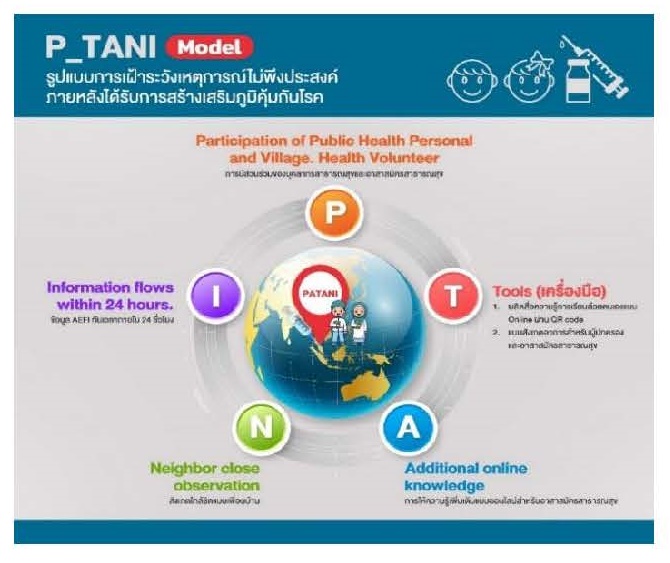Development of an Adverse Event Surveillance Model Following Basic Immunizations, Pattani Province
Keywords:
Development of an Operation Model, Surveillance of Adverse Events, Basic Immunizations, Village Health VolunteersAbstract
The objective of this research and development was to develop an adverse event surveillance model following basic immunizations in Pattani Province. The research process included three phases. The first phase was to study the situation, problems, needs, and management of the reporting of adverse events after vaccination using a qualitative research method. The key informants were 212 public health officials. The second phase was developing the model. The third phase was to examine the effectiveness of the model using a quasi-experimental research method. The participants were 27 public health officials and 135 village health volunteers. The data were analyzed using descriptive statistics. Comparing the knowledge level of village health volunteers before and after using the model employed Wilcoxon-signed rank test statistics.
The results showed that the model for monitoring adverse events after immunization is the P_TANI model, consisting of 1) the participation of village health volunteers; 2) the production of self-study knowledge media in two languages and a form for observing unusual symptoms; 3) online self-study for village health volunteers; 4) close observation as neighbors; and 5) reporting data within 24 hours. The results of the evaluation between before and after using the model found that village health volunteers had no difference in knowledge scores. Policy recommendations should allow service centers to increase their hours for providing vaccination services. Additionally, public health officials should control and supervise the work of village health volunteers in home visits and continuously report preschool children's symptoms after receiving the vaccine.
References
กนกทิพย์ ทิพย์รัตน์ และคณะ. (2563). แนวทางการเฝ้าระวังและตอบโต้เหตุการณ์ไม่พึงประสงค์ภายหลังได้รับการสร้างเสริมภูมิคุ้มกันโรคของประเทศไทย. กรุงเทพฯ: ห้างหุ้นส่วนจำกัด แคนนา กราฟฟิค.
กนกทิพย์ ทิพย์รัตน์. (2559). อาการภายหลังได้รับการสร้างเสริมภูมิคุ้มกันโรค (Adverse Events Following Immunization: AEFI). กรุงเทพฯ: สำนักระบาดวิทยา กรมควบคุมโรค กระทรวงสาธารณสุข.
กรกมล รุกขพันธ์ และคณิตา สุทธิทิปธรรมรงค์. (2561). ปัญหาและแนวทางการพัฒนาระบบเฝ้าระวังอาการภายหลัง ได้รับการสร้างเสริมภูมิคุ้มกันโรคในจังหวัดสงขลา. วารสารเภสัชกรรมไทย, 10(2), 517–532.
กองโรคป้องกันด้วยวัคซีน กรมควบคุมโรค กระทรวงสาธารณสุข. (2562). ตำราวัคซีนและการสร้างเสริมภูมิคุ้มกันโรค ปี 2562. พิมพ์ครั้งที่ 2. นนทบุรี: ชุมนุมสหกรณ์การเกษตรแห่งประเทศไทย จำกัด.
ต่อลาภ ฐิติเจริญศักดิ์ และคณะ. (2565). การศึกษาพฤติกรรมสารสนเทศด้านสุขภาพของผู้สูงอายุ. กรุงเทพฯ: มหาวิทยาลัยศรีนครินทรวิโรฒ.
ธนรักษ์ ผลิพัฒน์, เสาวพักตร์ ฮิ้นจ้อย, คำนวณ อึ้งชูศักดิ์, ปภานิจ สวงโท และอาทิชา วงศ์คำมา. (2557). ระบบเฝ้าระวังโรค 5 กลุ่มโรค 5 มิติ. กรุงเทพฯ: บริษัท ฮีร์ จำกัด.
ประกาย หมายมั่น. (2565). การพัฒนาระบบเฝ้าระวังอาการภายหลังได้รับการสร้างเสริมภูมิคุ้มกันโรค. วารสารการคุ้มครองผู้บริโภคด้านสุขภาพ, 2(1), 83–99.
พุฒิธร มาลาทอง, เทอดศักดิ์ พรหมอารักษ์ และสมศักดิ์ ศรีภักดี. (2564). กระบวนการพัฒนามาตรฐานการดำเนินงานสร้างเสริมภูมิคุ้มกันโรคใน หน่วยบริการปฐมภูมิของเครือข่ายบริการสุขภาพ อำเภอชำนิ จังหวัดบุรีรัมย์. วารสารวิชาการสาธารณสุขชุมชน, 7(3), 75–75.
ภาวินี ด้วงเงิน และคณะ. (2565). ผลการเฝ้าระวังเหตการณ์ไม่พึงประสงค์ภายหลังการได้รับวัคซีนป้องกันโควิด 19 ในประเทศไทย ระหว่างวันที่ 1 มีนาคม-31 ธันวาคม 2564, 10 เดือน ภายหลังการรณรงค์ฉีดวัคซีน. รายงานการเฝ้าระวังทางระบาดวิทยาประจำสัปดาห์, 53(31), 69–87.
วรัญญภรณ์ ชาลีรักษ. (2562). การพัฒนารูปแบบการติดตามและประเมินผลแบบมีส่วนร่วมให้ มีประสิทธิภาพตามหลักธรรมาภิบาลและสอดคล้องกับทิศทางการปฏิรูปการศึกษาของประเทศในยุคประเทศไทย 4.0.ฉะเชิงเทรา: สำนักงานศึกษาธิการภาค 9 สำนักงานปลัดกระทรวงศึกษาธิการ กระทรวงศึกษาธิการ.
อติญาณ์ ศรเกษตริน, รุ่งนภา จันทรา, รสติกร ขวัญชุม และลัดดา เรืองด้วง. (2560). ผลของโปรแกรมปรับเปลี่ยนพฤติกรรมสุขภาพตามแนวทาง 3อ.2ส. ของอาสาสมัครสาธารณสุข ประจำหมู่บ้าน (อสม.) ตำบลคลองฉนาก อำเภอเมือง จังหวัดสุราษฎร์ธานี. วารสารเครือข่ายวิทยาลัยพยาบาลและการสาธารณสุขภาคใต้, 4(1), 253–264.
อัญชลี ศิริพิทยาคุณกิจ และคณะ. (2561). หลักสูตรเชิงปฏิบัติการสำหรับเจ้าหน้าที่สร้างเสริมภูมิคุ้มกันโรค ปี 2561. พิมพ์ครั้งที่ 3. กรุงเทพฯ: บริษัท อมรินทร์พริ้นติ้ง แอนด์ พับลิชชิ่ง จำกัด (มหาชน).
อาทิตยา สมโลก และกฤษดี พ่วงรอด. (2563). เงื่อนไขที่เอื้อต่อความรอบรู้สุขภาพด้านการฉีดวัคซีนในเด็ก 0-12 ปี ในพื้นที่จังหวัดปัตตานี. ปัตตานี: มหาวิทยาลัยสงขลานครินทร์ ปัตตานี.
อีระฟาน หะยีอีแต และประภาภรณ์ หลังปูเต๊ะ. (2563). รูปแบบการส่งเสริมความครอบคลุมของวัคซีนในเด็ก 0-5 ปี จังหวัดยะลา. วารสาร อัล-ฮิกมะฮฺ มหาวิทยาลัยฟาฏอนี, 10(20), 137–148.
Boulding, K. E., & Bertalanffy, L. V. (1920). General system theory: Foundations, development, applications. New York: George Braziller.
Cohen, J. (1988). Statistical power analysis for the behavioral sciences. (2nd). Hillsdale, New Jersey: Lawrence Erlbaum Associates, Publishers.
Crabtree, B. F., & Miller, W. L. (1992). Doing qualitative research: Multiple strategies. Thousand Oaks, CA: Sage Publications.
Faul, F., Erdfelder, E., Lang, A. G., & Buchner, A. (2007). G*Power 3: A flexible statistical power analysis program for the social, behavioral, and biomedical sciences. Behavior Research Methods, 39(2), 175-191. doi: 10.3758/bf03193146
Pandey, D., Mehta, G., Sachdeva, M., & Tripathi, R. (2022). Adverse Event Following Immunization (AEFI) in children: An analysis of reporting in VigiAccess. Drug Research, 72(8), 435–440. https://doi.org/10.1055/a-1852-5335
Succi R. C. M. (2018). Vaccine refusal - what we need to know. Journal De Pediatric, 94(6), 574-581. https://doi.org/10.1016/j.jped.2018.01.008

Downloads
Published
How to Cite
Issue
Section
License
Copyright (c) 2023 Journal of Nursing and Public Health Research

This work is licensed under a Creative Commons Attribution-NonCommercial-NoDerivatives 4.0 International License.
1. บทความหรือข้อคิดเห็นใด ๆ ที่ปรากฏในวารสารวิจัยการพยาบาลและการสาธารณสุข ที่เป็นวรรณกรรมของผู้เขียน บรรณาธิการไม่จำเป็นต้องเห็นด้วย
2. บทความที่ได้รับการตีพิมพ์ถือเป็นลิขสิทธิ์ของ วารสารวิจัยการพยาบาลและการสาธารณสุข








